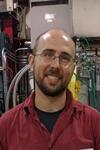Hugh Lippincott
There is a great deal of observational evidence across a wide variety of scales that a large fraction of the universe and most of the matter in the universe is made up of some form of non-baryonic, dark matter. The most prominent candidate for dark matter is the weakly interacting massive particle or WIMP, with a mass between 1 GeV to a few TeV, and there are many current experiments aiming to detect these particles directly. The DEAP/CLEAN program seeks to detect dark matter and pp-solar neutrinos using liquid argon and liquid neon as targets. When ionizing radiation interacts in these liquids, scintillation light is produced. The timing or pulse shape of scintillation provides pulse shape discrimination (PSD) with which to identify the type of recoil that occurred in the liquid. As WIMP-nucleus scattering events would produce nuclear recoils but most of the backgrounds produce electronic recoils, PSD provides background rejection, allowing liquid argon- and neon-based detectors to achieve excellent sensitivity to dark matter. In this work, I describe the evidence for dark matter and review the state of current detection efforts. I then discuss observations of scintillation in liquid argon and liquid neon performed in prototype detectors at Yale and underground at SNOLAB in Ontario, Canada, focusing on measurements of PSD, the nuclear recoil scintillation efficiency and alpha backgrounds in these detectors. I describe the implications of these measurements for both the argon and neon components of the DEAP/CLEAN program, including simulations of a possible 10-tonne liquid neon detector. In the first appendix, I describe efforts at Yale to build a thermal column for the separation of isotopes, with applications to both dark matter and neutrinoless double-beta decay searches. In the second appendix, I describe operation of an evaporator system.
